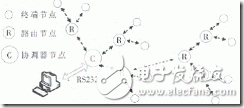Design of ZigBee Protocol Stack Software for Wireless Ad Hoc Network Node Hardware Design
The energy consumption of wireless ad hoc network nodes plays a crucial role in determining the overall lifespan of the network. ZigBee, based on the IEEE 802.15.4 standard, is an emerging short-range wireless communication technology known for its low power usage and cost-effectiveness. In this system, routing nodes do not have built-in sensor circuits, and due to their different functional roles, the software drivers for each node vary. The coordinator's software design includes initializing the device, establishing network connections, allowing both routing and sensor nodes to join, and managing data processing, including receiving and transmitting information.
Currently, monitoring and control systems in many areas rely heavily on wired networks. However, during installation and maintenance, cable damage or corrosion can lead to network disruptions, affecting normal operations and increasing labor costs. To address these issues, a wireless ad hoc network solution using ZigBee technology has been proposed. This approach focuses on reducing costs and improving network stability.
ZigBee technology, built on the IEEE 802.15.4 protocol, offers low power consumption, low cost, large network capacity, high reliability, and strong security. Sensor nodes equipped with ZigBee modules can efficiently coordinate multiple sensors and transfer data wirelessly through a relay-like process. ZigBee's digital transmission capabilities are widely applied in industries such as wireless communication, precision agriculture, home automation, consumer electronics, and healthcare. It is also a key area of focus in China's "Twelfth Five-Year Plan" for information technology development.
This paper discusses the hardware design of network nodes, the implementation of a ZigBee-based data transmission network structure, and the testing of a wireless Mesh network. The system collects data at the terminal nodes and routes it through multiple hops to the coordinator node, enabling a multi-node wireless ad hoc network.
**1. System Network Structure**
The network topology is illustrated in Figure 1, which shows a tree-based Mesh structure. The network consists of three main types of nodes: Coordinator, Router, and End Device.

**Figure 1: Network structure based on a tree-like wireless Mesh topology**
coin battery holder,cr2032 battery holder,cr2032 holder,cr2032 socket,cr2450 battery holder,cr2450 holder,2450 battery holder
Dongguan Yiyou Electronic Technology Co., Ltd. , https://www.dsubminiature.com